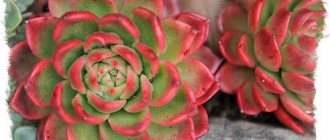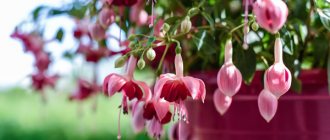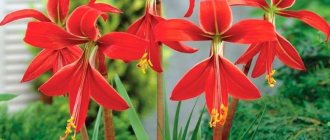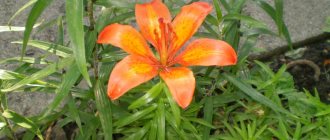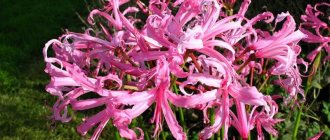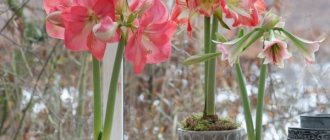Lilies are beautiful flowers, with an incredible aroma, which with their presence will transform the most modest flowerbed. There are many varieties and varieties of the plant that can amaze with different colors and petal patterns. There are garden and indoor lilies, perennial and annual, frost-resistant and those that can only be grown in the southern regions.
Everyone knows what a lily flower looks like; it has a unique appearance.
General description, flower characteristics
Lily is a herbaceous, bulbous plant. The height of the bushes, the timing of flowering and the color of the lily depend on the characteristics of a particular species.
Lily family Liliaceae, class Monocots. Latin name Lilium L.
In nature, there are more than 100 different plant species, native to North America and Asia.
The typical flower species is Lilium candidum or snow white.
The size of the bush varies depending on the type of plant. These can be small compact bushes no more than 30 cm high, or loose flowers up to 1.5 m high.
Description of bulbs, roots
There are two types of bulbs - scaly and bare. Shape: ovoid or round. They consist of several lobes that are located close to each other. The size of the bulbs is 1-30 cm.
The roots are thin, white, grow in a bunch, extending from the bulbous bottom.
Stem and leaves
The stem is straight, green. Length varies from 30 cm to 1.5 m.
The leaf blades are sessile, petioles are absent. The shape is linear-lanceolate. The average width is about 2 cm, length 20 cm.
Some species have aerial bulbs (bulbs) in the leaf axils, which are used in propagation.
What is common to all types of plants is the number of petals, but their shape, color, and presence of inclusions vary
Flowers, petals, seeds
How many petals does a lily have? There are 6 of them, each of which is separate. The color and shape are varied, depending on the species.
The shape can be straight, or curved at the end, cup-shaped, funnel-shaped or drooping.
The fruit of the lily is represented by a hexagonal cylindrical box, which bursts when fully ripe. The seeds are translucent, flat in shape.
Aroma
The smell of these flowers varies depending on the type and variety:
- strongly expressed suffocating;
- subtle;
- may be completely absent.
The field lily or saranka grows in the Crimea, the Caucasus and Southern Europe
Varieties and varieties
Varieties of lilies and their popular representatives:
- Asian are hybrids. They have strong immunity and are resistant to cold. The main colors are pink, white, yellow, burgundy. There is no smell.
- Martagon - has petals of an unusual, curly shape. The aroma is pleasant.
- Candidum - this type includes flowers painted white or milky. Candidum are capricious and require special care.
- American - two-color petals with various inclusions. The aroma is light. They are picky about the climate and have difficulty with transplanting.
- Long-flowered - tubular-shaped flowers, the color is predominantly white, the aroma is strong.
- Orleans and trumpet - flowers have a star or goblet shape. Common colors are red, pink and yellow.
- Oriental - characterized by different shades of petals. A distinctive feature is a yellow stripe that runs down the middle of each petal.
To divide into species, the growing conditions, the structure of the bulbs and seeds, and the shape of the inflorescence were taken into account.
Of all the varieties, the most recognizable are the eastern representatives of the plant, in which the color of the petals, although different, remains common, but the dividing stripe remains
What a lily looks like depends on its variety. The most popular and most sought after plants among gardeners:
- Lollipop - the petals are painted in two shades, there are speckles;
- Mystery Dream is a lily with an unusual color - the main color is light green with burgundy streaks;
- Lady Alice - flowers of a golden hue, tall bush, up to 150 cm;
- Purple Lady - yellow petals combined with purple stamens;
- Lavon - the height of the bush reaches 180 cm, the diameter of the flowers is 30 cm, the color is golden with a cherry stripe;
- Carmen is an unusual lily with thin, pointed petals of a rich ruby color.
Breeders regularly develop new varietal varieties of flowers, which are registered by the Royal Horticultural Society.
How do Asian hybrids differ from oriental ones?
Although in the photo it is easy to find similarities in the appearance of lilies representing different groups, exquisite orientals differ from Asian varieties in both color and flowering period, are more often susceptible to disease, and are capricious in care.
Fragrant oriental lilies bloom in mid-August, while Asian lilies open their buds at the end of June. The color of large graceful flowers, by which Orientals are recognized, is represented by pink and crimson shades; yellow is rare. Wide petals end in wavy edges.
The smaller, odorless flowers of Asian varieties are distinguished by their bright colors, orange, red, and yellow shades predominate, but white and pink petals are not uncommon, which are not as large as those of the oriental varieties.
Classification
Garden lily flowers have the following classification:
- Varietal or hybrids are flowers that are grown by gardeners. They are bred through selection, have a wide variety of colors, and are resistant to frost. A distinctive characteristic is the muted strength of the aroma.
- Wild or species - cultivated in botanical gardens and greenhouses. Growing them yourself is very difficult. There are about 16 wild species that have different colors and patterns on the petals.
Wild lilies have a very strong aroma, which can cause negative reactions in sensitive people: from headaches to real allergies and suffocation. Allergy sufferers should not live near such flowers.
One of the most popular wild representatives is the Leopard lily.
Planting material: purchase
Having decided on your desires, it’s time to go to the store for planting material.
This should not be done at the last moment, but in advance - long before the start of the planting season. After all, Dutch suppliers have the opportunity to send batches of bulbs all year round (there, in huge warehouses, lily bulbs are stored frozen), and stores purchase the first batches of live goods in January.
Then there are a few more deliveries, but by the beginning of spring - when, it would seem, it’s time to go to the garden and plant - there are already leftovers on the shelves. And these not yet sold lily bulbs are in very bad condition from being in a hot and dry room for too long!
However, in extreme cases, you can even buy overdried or slightly rotten bulbs - after all, garden lilies are resilient plants, and with good care they will still survive.
Features of growing garden varieties
When it is known what types of lilies there are, novice gardeners are faced with the question of how to grow certain varieties of flowers. When planting, all types of plants have the same requirements for choosing a location:
- nutritious and light soil;
- an area with abundant but diffuse lighting, which should not be exposed to direct sunlight during the day;
- the presence of drainage so that there is no stagnation of moisture after heavy rainfall or watering;
- absence of drafts and protection from strong winds.
Neutral soil is suitable for lilies. Some species prefer acidified or slightly alkaline soil.
Certain types of plants can be grown indoors in pots; their life indoors and the necessary agrotechnical measures are not much different from their outdoor counterparts.
Some varieties are suitable for home growing
To ensure the active formation of lily buds, it is necessary to observe a number of agrotechnical measures:
- the first year after planting, there is no need to apply fertilizer in the spring;
- replenishments are used once per season, provided that fertilizers were applied during planting;
- garter of tall plants;
- trimming the buds after they have completely faded.
The dates for planting in open soil are spring and early autumn with stable, warm weather.
Features of cultivation:
- watering - regular, moderate, carried out as the top layer of soil dries out;
- loosening and mulching - after each watering, pine chips or peat are used for mulch;
- fertilization;
- covering plants for the winter using pine branches or mulch;
- autumn pruning of completely dried stems.
When watering, water is poured strictly under the root; it is important to avoid getting moisture on the green part and buds.
Plants are replanted once every 3-5 years. The need to change the place for the lily will be indicated by such signs as a decrease in the number of buds and their size, or the bush completely stops blooming.
During a winter with little snow, even frost-resistant bushes need to be covered; without a thick layer of snow covering, the bulbs may not be able to withstand extreme cold.
Shelter for the winter
Reproduction
Lycoris is rarely propagated by seeds, since only a few species produce productive seeds. Most often, the vegetative method is used for propagation.
Each year the plant grows several daughter bulbs. At the end of the season, the babies are ready for independent growth and can be separated.
However, the plant cannot be divided often, as it weakens and may not bloom for a couple of years.
- After flowering, dig up the bulb;
- Carefully separate them from each other;
- After separation, plant the daughter bulb in a new place, and plant the mother bulb back.
Application on the farm
The description of a lily always mentions a delicate, although sometimes quite strong, scent. It is believed that the aroma of the flower has a calming effect on a person’s psycho-emotional state and helps increase stress resistance.
Lily is included in some cosmetics and is used in perfumes. In the Far East and Siberia, onions of two-row flowers are used for food.
Some varieties of the flower are poisonous. Toxic substances are contained in pollen and juice.
Lilies – photo
And so that you have the opportunity to admire the beauty of charming lilies, we have prepared a large selection of photographs!
Photo: e-semena.ru
Photo: voteregion-ntf.ru
Photo: mir-ogorodnikov.ru
Photo: u-florista.ru
Photo: rayskisad.ru
Photo: sad-mos.ru
Photo: 2sotki.ru
Photo: sad-mos.ru
Photo: pro-remont.mediasalt.ru
Photo: fedsp.com
Photo: oir.mobi
Photo: mysticgarden.ru
Photo: tr.pinterest.com
Photo: prorastet.ru
Photo: 2sotki.ru
Photo: fotokto.ru
Photo: glav-dacha.ru
Photo: funart.pro
Photo: 2sotki.ru
Photo: sad-dom.com
Photo: zen.yandex.ua
Photo: 2sotki.ru
Photo: flo.discus-club.ru
Photo: liveinternet.ru
Did you like the post? Subscribe to our channel in Yandex.Zen, it really helps us in our development!
Interesting facts about the plant
Lily has always been shrouded in an aura of mystery. There are many secrets, legends and beliefs associated with this plant:
- in Rome, the lily was a sign of wealth and taste;
- in France, the flower was a symbol of power; during the reign of Louis XIV, the country was called the kingdom of lilies;
- in Spain, the lily is a symbol of purity and innocence, purity of the soul;
- the image of a flower is often used in heraldry.
In many countries there is a belief that lilies are fallen stars. If you see a falling star and make a wish, and in the morning you meet this beautiful flower, your wish will definitely come true.
The well-known water lily is not related to bush flowers; it is the general name of plants of the genera egg capsule, lotus, and water lily.
